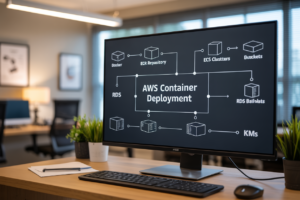Need to run complex workloads without managing infrastructure? AWS Batch helps developers, data scientists, and IT teams automate and scale compute-intensive jobs in the cloud. This guide walks you through essential AWS Batch concepts and practical implementation steps. You’ll learn how to set up your first AWS Batch environment, optimize performance while controlling costs, and implement advanced scaling techniques for high-volume processing workloads.
Understanding AWS Batch Fundamentals
What is AWS Batch and why it matters for your workloads
AWS Batch takes the headache out of running thousands of batch computing jobs. No more wrestling with servers or scheduling software. Just drop in your code, define your resources, and AWS handles everything else—scaling automatically as needed and only charging for what you use. Perfect for when you need serious compute power without the complexity.
Setting Up Your First AWS Batch Environment
Setting Up Your First AWS Batch Environment
A. Creating compute environments tailored to your needs
Ever tried squeezing a square peg into a round hole? That’s what running specialized workloads on generic compute feels like. AWS Batch lets you build environments that match your exact needs – from memory-hungry data processing to CPU-intensive simulations. Pick your instance types, configure auto-scaling, and only pay for what you actually use.
Optimizing Job Performance and Costs
Optimizing Job Performance and Costs
A. Selecting the right instance types for your workloads
Picking the wrong EC2 instance type is like bringing a knife to a gunfight. Your compute-intensive jobs need instances with serious CPU power, while memory-hungry applications require high-RAM options. Don’t overpay for resources you’ll never use. Match your workload characteristics to instance capabilities and watch your performance soar.
B. Implementing auto-scaling strategies that work
Auto-scaling isn’t just a checkbox feature—it’s your secret weapon. Configure scaling policies based on queue depth, not arbitrary schedules. Set appropriate cooldown periods to prevent thrashing, and implement gradual scaling to avoid capacity shocks. The best auto-scaling setup feels invisible, quietly handling load spikes without you lifting a finger.
C. Spot instance integration to reduce costs by 90%
Spot instances are practically free money sitting on the table. By designing your batch jobs to be interruption-tolerant, you can tap into these discount instances and slash your compute costs dramatically. The trick? Implement checkpointing in your applications and set up automatic retry mechanisms. Your finance team will think you’re a wizard.
D. Monitoring and analyzing batch job performance
Flying blind with batch jobs is a recipe for disaster. Set up CloudWatch dashboards tracking key metrics like job duration, queue wait times, and resource utilization. Look for bottlenecks in your processing pipeline and address them systematically. The performance patterns you spot today are tomorrow’s optimization opportunities.
Advanced Scaling Techniques for High-Volume Processing
Advanced Scaling Techniques for High-Volume Processing
A. Handling dependencies between batch jobs
AWS Batch’s job dependencies feature isn’t just convenient—it’s a game-changer for complex workflows. Simply tag your jobs with “dependsOn” parameters and watch AWS handle the sequencing automatically. No more babysitting job chains or building custom schedulers. Your ETL processes will practically run themselves!
B. Implementing parallel processing for faster results
Want to slash processing time? Break your workload into chunks and let parallel processing do its magic. With AWS Batch, you can spin up hundreds of containers simultaneously, turning day-long jobs into hour-long ones. The best part? You pay only for what you use, making massive scale-ups surprisingly affordable.
C. Managing priorities across multiple job queues
Stop letting low-priority tasks hijack your computing resources. Create separate job queues with different priority levels and compute environments. Critical financial calculations can take precedence over routine reports, while your infrastructure dynamically adjusts to meet demand. Smart prioritization equals better resource utilization and happier users.
Real-World AWS Batch Implementation Strategies
A. Container integration with Docker and ECR
Ever tried running batch jobs without containers? Total nightmare. Docker and Amazon ECR make AWS Batch implementation dead simple. Package your code, dependencies, and runtime in Docker images, push them to ECR, and AWS Batch handles the rest. No more “works on my machine” excuses.
AWS Batch transforms the complex world of batch computing into a streamlined cloud service, enabling you to focus on your workloads rather than infrastructure management. As we’ve explored, the journey from understanding fundamentals to implementing advanced scaling techniques empowers you to run batch jobs efficiently while optimizing both performance and costs. The ability to automatically provision resources based on your specific requirements eliminates capacity planning headaches and ensures you only pay for what you use.
Take the next step in your cloud computing journey by implementing AWS Batch for your data processing needs. Whether you’re running simulations, processing media files, or analyzing large datasets, AWS Batch provides the flexibility and scalability to handle your workloads effectively. Start with a simple implementation, monitor your performance metrics, and gradually incorporate advanced features to build a robust batch processing system that grows with your business needs.




















